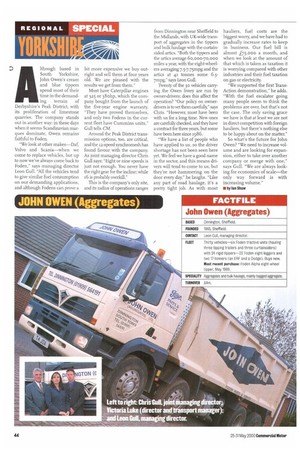A D lthough based in
Page 46

If you've noticed an error in this article please click here to report it so we can fix it.
South Yorkshire, John Owen's cream and blue tippers spend most of their time in the demanding terrain of Derbyshire's Peak District, with its proliferation of limestone quarries. The company stands Out in another way: in these days when it seems Scandinavian marques dominate, Owen remains faithful to Foden.
"We look at other makes—Daf, Volvo and Scania—when we come to replace vehicles, but up to now we've always come back to Foden," says managing director Leon Gull. All the vehicles tend to give similar fuel consumption on our demanding applications, and although Fodens can prove a
bit more expensive we buy outright and sell them at four years old. We are pleased with the results we get from them."
Most have Caterpillar engines at 325 Or 38ohp, which the Company bought from the launch of the five-year engine warranty. "They have proved themselves, and only two Fodens in the current fleet have Cummins units," Gull tells CM.
Around the Peak District transmission options, too, are critical, and the 12-speed synchromesh has found favour with the company. As joint managing director Chris Gull says: "Eight or nine speeds is just not enough. You never have the right gear for the incline; while i6 is probably overkill."
This is the company's only site, and its radius of operations ranges from Dinnington near Sheffield to the Midlands, with UK-wide transport of aggregates in the tippers and bulk haulage with the curtainsided artics. "Both the tippers and the artics average 60,000-70,000 miles a year, with the eight-wheelers averaging 7.5-7.75mpg and the artics at 41 tonnes some 6.57mpg," says Leon Gull.
Twenty of the 3o vehicles carrying the Owen livery are run by owner-drivers; does this affect the operation? "Our policy on ownerdrivers is to vet them carefully" says Chris. "However, most have been with us for a long time, New ones are carefully checked, and they have a contract for three years, but some have been here since 1986.
"We have a list of people who have applied to us, so the driver shortage has not been seen here yet. We feel we have a good name in the sector, and this means drivers will tend to come to us, but they're not hammering on the door every day," he laughs. "Like any part of road haulage, it's a pretty tight job. As with most hauliers, fuel costs are the biggest worry, and we have had to gradually increase rates to keep in business. Our fuel bill is almost f75,0oo a month, and when we look at the amount of that which is taken as taxation it is worrying compared with other industries and their fuel taxation on gas or electricity.
"We supported the first TransAction demonstration," he adds. "With the fuel escalator going many people seem to think the problems are over, but that's not the case. The only saving grace we have is that at least we are not in direct competition with foreign hauliers, but there's nothing else to be happy about on the matter."
So what's the future for John Owen? "We need to increase volume and are looking for expansion, either to take over another company or merge with one," says Gull. "We are always looking for economies of scale—the only way forward is with increasing volume."
• by Ian Shaw
















































































































